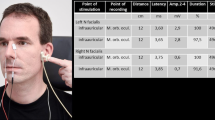Abstract
The aim of the present study was to evaluate the thyroarytenoid muscle response during bilateral thyroid surgery using vagal nerve stimulation. 195 patients (390 nerves at risk) underwent a total thyroidectomy. The recurrent laryngeal nerve’s function was checked by analyzing the amplitude and the latency of the thyroarytenoid muscle’s responses after a vagal nerve’s stimulation (0.5 and 1 mA) using the NIM3 Medtronic system. All patients were submitted to preoperative and postoperative laryngoscopy. 20 patients get no thyroarytenoid muscle response to the vagal nerve stimulation, and 14 postoperative recurrent laryngeal nerve palsies were confirmed (3.8 %). Two palsies were present after 6 months (0.51 %). All the patients with muscle’s response have normal mobility vocal fold. The test sensitivity was 100 % and the test specificity was 98 %. Physiologically, the mean latencies of the muscular potentials for the right RLN were, respectively, 3.89 and 3.83 ms (p > 0.05) for the stimulation at 0.5 and 1 mA. The mean latencies for the left RLN were, respectively, 6.25 and 6.22 ms for the stimulation at 0.5 and 1 mA (p > 0.05). The difference of the latencies between the right and the left nerve was 2.30 ms (1.75–3.25 ms) with a stimulation of 0.5 or 1 mA (p < 0.05). Thyroarytenoid muscle’s response via a vagal nerve stimulation showed a functional asymmetry of the laryngeal adduction with a faster right response. Surgically, this method can predict accurately an immediate postoperative vocal folds function in patients undergoing a bilateral thyroid surgery.


Similar content being viewed by others
References
Munch S, deKryger L (2001) A piece of my mind. Moral wounds: complicated complications. JAMA 285:1131–1132
Jatzko GR, Lisborg PH, Müller MG, Wette VM (1994) Recurrent nerve palsy after thyroid operations: principal nerve identification and a literature review. Surgery 115:139–144
Wagner HE, Seiler C (1994) Recurrent laryngeal nerve palsy after thyroid gland surgery. Br J Surg 81:226–228
Lahey FH (1938) Routine dissection and demonstration of the recurrent laryngeal nerve in subtotal thyroidectomy. Surg Gynecol Obstet 66:775–777
Calò PG, Pisano G, Medas F, Pittau MR, Gordini L, Demontis R, Nicolosi A (2014) Identification alone versus intraoperative neuromonitoring of the recurrent laryngeal nerve during thyroid surgery: experience of 2034 consecutive patients. J Otolaryngol Head Neck Surg 43:16
Dralle H, Sekulla C, Lorenz K, Brauckhoo M, Machens A (2008) Intraoperative monitoring of the recurrent laryngeal nerve in thyroid surgery. World J Surg 32:1358–1366
Hillermann CL, Tarpey J, Phillips DE (2003) Laryngeal nerve identification during thyroid surgery: feasibility of a novel approach. Can J Anaesth 50:189–192
Randolph GW, Kobler JB, Wilkins J (2004) Recurrent laryngeal nerve identification and assessment during thyroid surgery: laryngeal palpation. World J Surg 28:755–760
Tschopp KP, Gottardo C (2002) Comparison of various methods of electromyographic monitoring of the recurrent laryngeal nerve in thyroid surgery. Ann Otol Rhinol Laryngol 111:811–816
Chiang FY, Lu IC, Kuo WR, Lee KW, Chang NC, Wu CW (2008) The mechanism of recurrent laryngeal nerve injury during thyroid surgery–the application of intraoperative neuromonitoring. Surgery 143:743–749
Genther DJ, Kandil EH, Noureldine SI, Tufano RP (2014) Correlation of final evoked potential amplitudes on intraoperative electromyography of the recurrent laryngeal nerve with immediate postoperative vocal fold function after thyroid and parathyroid surgery. JAMA Otolaryngol Head Neck Surg 140:124–128
Caragacianu D, Kamani D, Randolph GW (2013) Intraoperative monitoring: normative range associated with normal postoperative glottic function. Laryngoscope 123:3026–3031
Lipton RJ, McCaffrey TV, Litchy WJ (1988) Intraoperative electrophysiologic monitoring of laryngeal muscle during thyroid surgery. Laryngoscope 98:1292–1296
Thomusch O, Sekulla C, Machens A, Neumann HJ, Timmermann W, Dralle H (2004) Validity of intra-operative neuromonitoring signals in thyroid surgery. Arch Surg 389:499–503
Alon EE, Hinni ML (2009) Transcricothyroid electromyographic monitoring of the recurrent laryngeal nerve. Laryngoscope 119:1918–1921
Petro ML, Schweinfurth JM, Petro AB (2006) Transcricothyroid, intraoperative monitoring of the vagus nerve. Arch Otolaryngol Head Neck Surg 132:624–628
Hermann M, Hellebart C, Freissmuth M (2004) Neuromonitoring in thyroid surgery. Ann Surg 240:9–17
Woltering EA, Dumond D, Ferrara J, Farrar WB, James AG (1984) A method for intraoperative identification of the recurrent laryngeal nerve. Am J Surg 148:438–440
Jeannon JP, Orabi AA, Bruch GA, Abdalsalam HA, Simo R (2009) Diagnosis of recurrent laryngeal nerve palsy after thyroidectomy: a systematic review. Int J Clin Pract 63:624–629
Schneider R, Przybyl J, Pliquett U, Hermann M, Wehner M, Pietsch UC et al (2010) A new vagal anchor electrode for real-time monitoring the recurrent laryngeal nerve. Am J Surg 199:507–514
Ulmer C, Koch KP, Seimer A, Molnar V, Meyding-Lamadé U, Thon KP, Lamadé W (2008) Real-time monitoring of the recurrent laryngeal nerve: an observational clinical trial. Surgery 143:359–365
Prades JM, Dubois MD, Dumollard JM, Tordella L, Rigail J, Timoshenko AP, Peoc’h M (2012) Morphological and functional asymmetry of the human recurrent laryngeal nerve. Surg Radiol Anat 34:903–908
Phelan E, Schneider R, Lorenz K, Dralle H, Kamani D, Potenza A, Sritharan N, Shin J, Randolph GW (2014) Continuous vagal IONM prevents recurrent laryngeal nerve paralysis by revealing initial EMG changes of impending neuropraxic injury: a prospective, multicenter study. Laryngoscope 124:1498–1505
Sritharan N, Chase M, Kamani D, Randolph M, Randolph GW (2015) The vagus nerve, recurrent laryngeal nerve, and external branch of the superior laryngeal nerve have unique latencies allowing for intraoperative documentation of intact neural function during thyroid surgery. Laryngoscope 125:E84–E89
Darr EA, Tufano RP, Ozdemir S, Kamani D, Hurwitz S, Randolph G (2014) Superior Laryngeal nerve quantitative intraoperative monitoring is possible in all thyroid surgeries. Laryngoscope 124:1035–1041
Author information
Authors and Affiliations
Corresponding author
Ethics declarations
Conflict of interest
The authors have no financial interests to declare in relation to the content of this article.
Ethical standards
The authors declare that the study comply with the current ethical laws of the state of France.
Rights and permissions
About this article
Cite this article
Farizon, B., Gavid, M., Karkas, A. et al. Intraoperative monitoring of the recurrent laryngeal nerve by vagal nerve stimulation in thyroid surgery. Eur Arch Otorhinolaryngol 274, 421–426 (2017). https://doi.org/10.1007/s00405-016-4191-2
Received:
Accepted:
Published:
Issue Date:
DOI: https://doi.org/10.1007/s00405-016-4191-2




